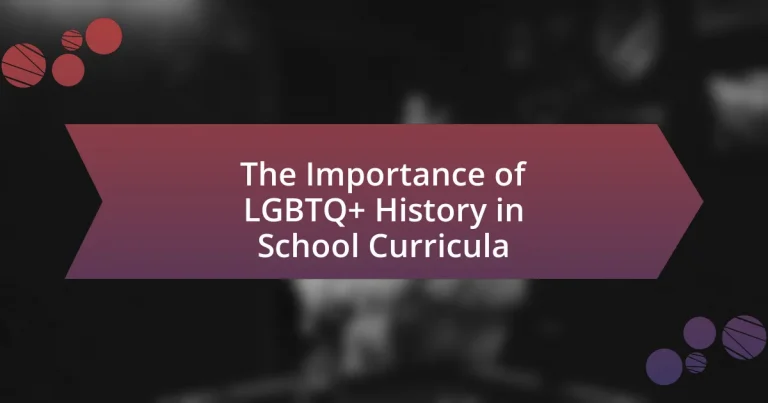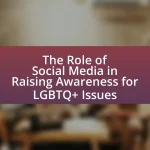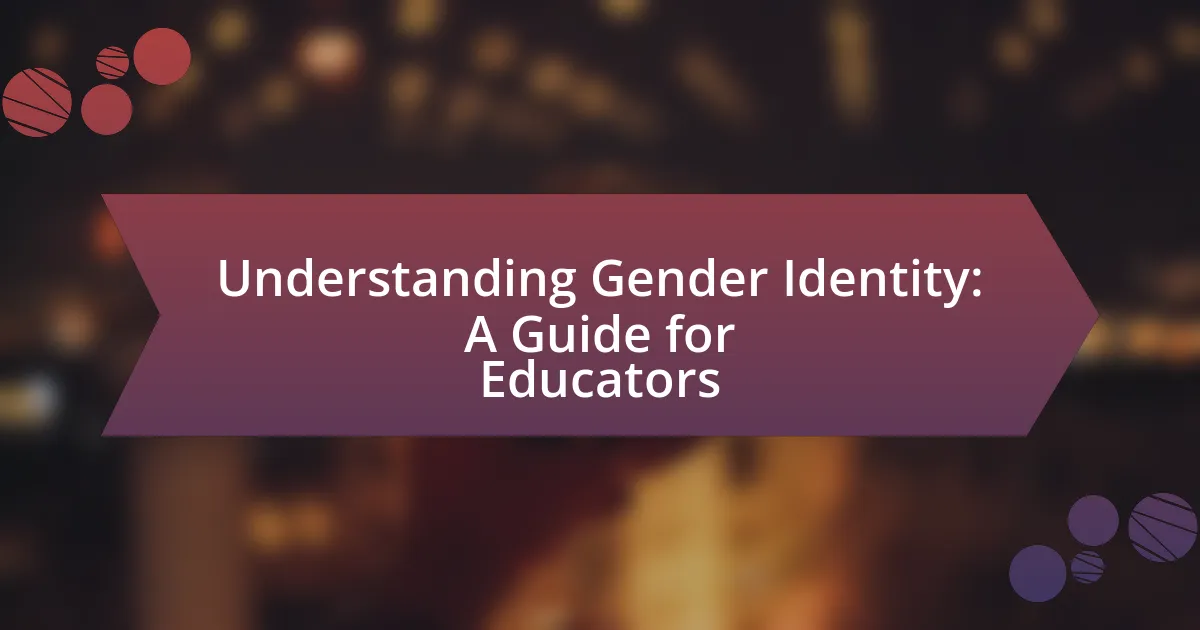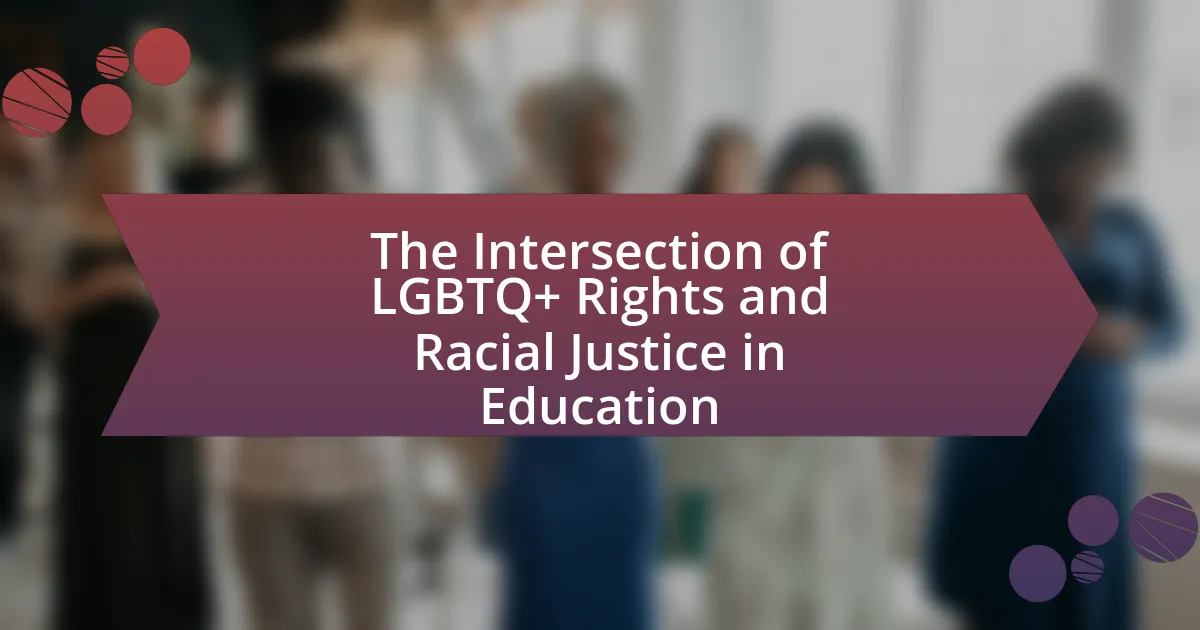The article emphasizes the significance of incorporating LGBTQ+ history into school curricula, highlighting its role in promoting inclusivity, understanding, and empathy among students. It discusses the positive impact of inclusive education on mental health and safety for LGBTQ+ students, as well as the detrimental effects of omitting LGBTQ+ history, which can lead to isolation and discrimination. The article also addresses the challenges educators face in integrating LGBTQ+ topics, such as societal resistance and lack of resources, while providing strategies and resources to effectively teach LGBTQ+ history. Overall, it underscores the importance of representation and the benefits of fostering a more accepting and informed school environment.

Why is LGBTQ+ History Important in School Curricula?
LGBTQ+ history is important in school curricula because it promotes inclusivity and understanding of diverse identities and experiences. Incorporating LGBTQ+ history helps students recognize the contributions and struggles of LGBTQ+ individuals throughout history, fostering empathy and reducing prejudice. Research indicates that inclusive curricula can improve the mental health and well-being of LGBTQ+ students, as evidenced by a study from GLSEN, which found that schools with inclusive curricula reported lower rates of bullying and higher levels of safety for LGBTQ+ students. By teaching LGBTQ+ history, schools prepare all students to engage in a diverse society, enhancing social cohesion and respect for human rights.
What are the key reasons for including LGBTQ+ history in education?
Including LGBTQ+ history in education is essential for fostering inclusivity and understanding in society. This inclusion helps students recognize the contributions and struggles of LGBTQ+ individuals throughout history, promoting empathy and reducing prejudice. Research indicates that when LGBTQ+ history is taught, it can lead to a more accepting school environment, as evidenced by a study from GLSEN, which found that LGBTQ-inclusive curricula significantly reduce bullying and harassment in schools. Furthermore, understanding LGBTQ+ history aids in the development of a comprehensive worldview, allowing students to appreciate diverse identities and experiences, which is crucial in a multicultural society.
How does LGBTQ+ history contribute to a more inclusive learning environment?
LGBTQ+ history contributes to a more inclusive learning environment by fostering understanding and acceptance of diverse identities. When educational curricula include LGBTQ+ history, students learn about the struggles and achievements of LGBTQ+ individuals, which promotes empathy and reduces prejudice. Research indicates that inclusive curricula can lead to improved mental health outcomes for LGBTQ+ students; for example, a study published in the Journal of School Health found that students who learned about LGBTQ+ issues reported feeling safer and more supported in their schools. By integrating LGBTQ+ history, schools create a space where all students feel valued and respected, enhancing overall educational experiences.
What impact does LGBTQ+ history have on student identity and self-acceptance?
LGBTQ+ history significantly impacts student identity and self-acceptance by providing representation and validation of diverse sexual orientations and gender identities. When students learn about historical figures and events related to LGBTQ+ communities, they can see reflections of their own experiences, which fosters a sense of belonging and reduces feelings of isolation. Research indicates that inclusive curricula can improve mental health outcomes for LGBTQ+ youth; for instance, a study published in the Journal of Youth and Adolescence found that LGBTQ+ students who learned about LGBTQ+ history reported higher levels of self-acceptance and lower levels of depression. This historical context not only affirms their identities but also empowers students to embrace their authentic selves.
How does the absence of LGBTQ+ history affect students?
The absence of LGBTQ+ history negatively affects students by perpetuating a lack of representation and understanding of diverse identities. This omission can lead to feelings of isolation among LGBTQ+ students, as they may not see their experiences reflected in the curriculum, which can contribute to lower self-esteem and increased mental health issues. Research indicates that inclusive curricula improve the overall school climate and reduce bullying; for instance, a study by GLSEN found that LGBTQ+ inclusive curricula are associated with lower levels of victimization and higher levels of safety for LGBTQ+ students. Therefore, the lack of LGBTQ+ history not only marginalizes these students but also hinders the development of empathy and awareness among their peers.
What are the consequences of erasing LGBTQ+ contributions from history?
Erasing LGBTQ+ contributions from history leads to a distorted understanding of societal development and cultural progress. This omission perpetuates ignorance and reinforces harmful stereotypes, which can result in increased discrimination and marginalization of LGBTQ+ individuals. Historical evidence shows that LGBTQ+ figures have significantly influenced various fields, such as art, science, and politics; for instance, figures like Alan Turing in computer science and James Baldwin in literature have shaped modern thought. By excluding these contributions, educational curricula fail to provide a comprehensive view of history, which can hinder empathy and acceptance among students. Furthermore, the lack of representation can negatively impact the self-esteem and identity formation of LGBTQ+ youth, as they may feel invisible or unworthy in a society that disregards their history.
How does a lack of representation influence bullying and discrimination in schools?
A lack of representation in schools significantly contributes to bullying and discrimination, particularly against marginalized groups such as LGBTQ+ students. When students do not see themselves reflected in the curriculum or among faculty, it fosters an environment where stereotypes and biases can thrive, leading to increased instances of bullying. Research indicates that schools with inclusive curricula that represent diverse identities experience lower rates of bullying and discrimination. For example, a study by GLSEN found that LGBTQ+ students who learned about LGBTQ+ history in school reported feeling safer and more accepted, highlighting the importance of representation in reducing negative behaviors.

What are the Challenges in Integrating LGBTQ+ History into Curricula?
Integrating LGBTQ+ history into curricula faces several challenges, including societal resistance, lack of resources, and insufficient teacher training. Societal resistance often stems from cultural and political opposition, which can lead to the exclusion of LGBTQ+ topics in educational settings. Additionally, many schools lack adequate resources, such as textbooks and teaching materials that accurately represent LGBTQ+ history, making it difficult for educators to incorporate these topics effectively. Furthermore, teachers often receive limited training on LGBTQ+ issues, which can hinder their confidence and ability to teach this history comprehensively. These challenges collectively contribute to the underrepresentation of LGBTQ+ history in school curricula.
What obstacles do educators face when teaching LGBTQ+ history?
Educators face significant obstacles when teaching LGBTQ+ history, primarily due to societal stigma and lack of institutional support. Many educators encounter resistance from parents, administrators, and community members who may oppose the inclusion of LGBTQ+ topics in the curriculum, fearing it conflicts with their personal beliefs or values. Additionally, a lack of comprehensive training and resources on LGBTQ+ history can hinder educators’ ability to teach the subject effectively. Research indicates that only 17% of U.S. history teachers feel adequately prepared to teach LGBTQ+ content, highlighting a gap in professional development. Furthermore, state laws in some regions restrict discussions around LGBTQ+ issues, creating legal barriers that educators must navigate. These factors collectively contribute to a challenging environment for teaching LGBTQ+ history in schools.
How do societal attitudes impact the inclusion of LGBTQ+ topics in schools?
Societal attitudes significantly influence the inclusion of LGBTQ+ topics in schools by shaping educational policies and curriculum decisions. When communities exhibit acceptance and support for LGBTQ+ individuals, schools are more likely to incorporate LGBTQ+ history and issues into their curricula, reflecting a commitment to diversity and inclusion. Conversely, negative societal attitudes can lead to resistance against such inclusivity, resulting in limited or no representation of LGBTQ+ topics in educational settings. Research indicates that states with more progressive attitudes towards LGBTQ+ rights tend to have more comprehensive educational policies that include LGBTQ+ content, as seen in the 2019 GLSEN National School Climate Survey, which found that schools in supportive environments were more likely to teach about LGBTQ+ history.
What resources are available to help educators overcome these challenges?
Educators can access various resources to help overcome challenges related to incorporating LGBTQ+ history into school curricula. Organizations such as the Human Rights Campaign provide comprehensive teaching materials, lesson plans, and professional development workshops specifically focused on LGBTQ+ topics. Additionally, the GLSEN (Gay, Lesbian & Straight Education Network) offers resources that include research-based strategies for creating inclusive classrooms and curricula. Studies indicate that inclusive education positively impacts student well-being and academic performance, reinforcing the importance of these resources. Furthermore, the Teaching Tolerance project by the Southern Poverty Law Center provides free educational resources that promote diversity and inclusion, including LGBTQ+ history. These resources collectively support educators in effectively addressing challenges and fostering an inclusive learning environment.
How can schools effectively implement LGBTQ+ history in their curricula?
Schools can effectively implement LGBTQ+ history in their curricula by integrating it into existing subjects such as social studies, literature, and health education. This approach allows for a comprehensive understanding of LGBTQ+ contributions and experiences throughout history, fostering inclusivity and awareness. For instance, including figures like Marsha P. Johnson and Harvey Milk in discussions about civil rights movements highlights their significant roles. Research indicates that inclusive curricula can improve school climate and reduce bullying, as shown in a study by GLSEN, which found that LGBTQ+ inclusive curricula led to a 30% decrease in victimization based on sexual orientation. By training educators on LGBTQ+ topics and providing appropriate resources, schools can create a supportive environment that acknowledges and respects diverse identities.
What strategies can educators use to introduce LGBTQ+ topics in a sensitive manner?
Educators can introduce LGBTQ+ topics sensitively by creating an inclusive curriculum that reflects diverse identities and experiences. This can be achieved by integrating LGBTQ+ history and literature into existing subjects, ensuring representation in classroom materials, and fostering an open environment for discussion. Research indicates that inclusive curricula can improve the school climate and reduce bullying; for instance, a study by GLSEN found that LGBTQ+ inclusive curricula significantly decrease harassment and improve student well-being. Additionally, educators should engage in professional development to understand LGBTQ+ issues better and utilize age-appropriate language to discuss these topics, ensuring that all students feel respected and valued.
How can collaboration with LGBTQ+ organizations enhance curriculum development?
Collaboration with LGBTQ+ organizations can enhance curriculum development by integrating diverse perspectives and accurate representations of LGBTQ+ history and issues. This partnership allows educators to access resources, training, and expertise that ensure curricula are inclusive and reflective of the experiences of LGBTQ+ individuals. For instance, research by the Gay, Lesbian and Straight Education Network (GLSEN) indicates that inclusive curricula can lead to safer school environments and improved academic outcomes for all students. By working with LGBTQ+ organizations, schools can develop educational materials that not only educate students about LGBTQ+ history but also promote understanding and acceptance, thereby fostering a more inclusive educational atmosphere.

What are the Benefits of Teaching LGBTQ+ History in Schools?
Teaching LGBTQ+ history in schools promotes inclusivity and understanding, fostering a more accepting environment for all students. By integrating LGBTQ+ history into curricula, schools can help combat discrimination and bullying, as studies show that inclusive education reduces instances of harassment. For example, research from the Gay, Lesbian & Straight Education Network (GLSEN) indicates that students in schools with inclusive curricula report feeling safer and more supported. Additionally, teaching LGBTQ+ history provides students with a more comprehensive understanding of societal development, highlighting the contributions and struggles of LGBTQ+ individuals throughout history, which enriches their overall educational experience.
How does LGBTQ+ history education promote empathy and understanding?
LGBTQ+ history education promotes empathy and understanding by providing students with insights into the diverse experiences and struggles faced by LGBTQ+ individuals throughout history. This education highlights significant events, such as the Stonewall Riots and the AIDS crisis, which illustrate the challenges and resilience of the LGBTQ+ community. By learning about these historical contexts, students can develop a deeper appreciation for the complexities of identity and the impact of societal attitudes on marginalized groups. Research indicates that inclusive curricula can reduce prejudice and foster a more accepting environment, as evidenced by a study published in the Journal of Homosexuality, which found that students exposed to LGBTQ+ history were more likely to express empathy towards LGBTQ+ peers.
What role does LGBTQ+ history play in fostering respect for diversity?
LGBTQ+ history plays a crucial role in fostering respect for diversity by highlighting the struggles, achievements, and contributions of LGBTQ+ individuals throughout history. This inclusion in educational curricula promotes understanding and empathy among students, as it provides a broader perspective on human experiences and social justice. For instance, studies have shown that when students learn about LGBTQ+ history, they are more likely to develop positive attitudes towards diversity and inclusivity, reducing instances of bullying and discrimination. By recognizing the historical context of LGBTQ+ rights movements, such as the Stonewall Riots of 1969, students can appreciate the ongoing fight for equality and the importance of respecting all identities.
How can LGBTQ+ history education improve mental health outcomes for students?
LGBTQ+ history education can improve mental health outcomes for students by fostering a sense of belonging and reducing stigma. When students learn about LGBTQ+ history, they gain insights into the struggles and achievements of LGBTQ+ individuals, which can validate their own identities and experiences. Research indicates that inclusive curricula can lead to lower rates of depression and anxiety among LGBTQ+ youth. For instance, a study published in the Journal of School Health found that students who attended schools with inclusive curricula reported better mental health and higher self-esteem. This educational approach not only promotes acceptance but also equips students with the knowledge to challenge discrimination, ultimately contributing to a more supportive school environment.
What skills do students gain from learning about LGBTQ+ history?
Students gain critical thinking, empathy, and historical awareness from learning about LGBTQ+ history. Critical thinking skills are developed as students analyze historical events, movements, and the social dynamics surrounding LGBTQ+ issues, enabling them to evaluate sources and perspectives. Empathy is fostered through understanding the struggles and contributions of LGBTQ+ individuals, which helps students appreciate diverse experiences and perspectives. Historical awareness is enhanced as students learn about the timeline of LGBTQ+ rights and activism, including significant events such as the Stonewall Riots in 1969, which marked a pivotal moment in the fight for LGBTQ+ rights. This knowledge equips students with a broader understanding of social justice and human rights issues.
How does studying LGBTQ+ history enhance critical thinking and analysis skills?
Studying LGBTQ+ history enhances critical thinking and analysis skills by encouraging students to examine diverse perspectives and challenge societal norms. This examination fosters an understanding of complex social issues, as students analyze historical events, movements, and figures within the LGBTQ+ community. For instance, exploring the Stonewall Riots of 1969 allows students to critically assess the intersection of civil rights and LGBTQ+ activism, highlighting the importance of context in historical narratives. Engaging with primary sources, such as personal testimonies and archival materials, further develops analytical skills by requiring students to interpret and evaluate differing viewpoints. This process not only cultivates empathy but also equips students with the ability to think critically about contemporary social justice issues, reinforcing the relevance of LGBTQ+ history in understanding broader societal dynamics.
What communication skills can students develop through discussions on LGBTQ+ topics?
Students can develop critical communication skills such as active listening, empathy, and respectful dialogue through discussions on LGBTQ+ topics. Engaging in these discussions encourages students to listen attentively to diverse perspectives, fostering an understanding of different experiences and identities. This process enhances their ability to articulate their thoughts clearly and respectfully, which is essential in any discourse. Research indicates that students who participate in inclusive discussions demonstrate improved interpersonal skills and a greater capacity for empathy, as they learn to navigate complex social issues and communicate effectively with peers from various backgrounds.
What are some best practices for teaching LGBTQ+ history effectively?
To teach LGBTQ+ history effectively, educators should incorporate diverse perspectives, utilize inclusive materials, and create a safe learning environment. Diverse perspectives ensure that students learn about various LGBTQ+ figures and movements, such as the Stonewall Riots and the contributions of individuals like Marsha P. Johnson and Harvey Milk. Utilizing inclusive materials, including books, documentaries, and primary sources, allows students to engage with authentic narratives. Creating a safe learning environment involves establishing ground rules for respectful discussion and addressing any biases, which fosters open dialogue and critical thinking. Research indicates that inclusive curricula can improve student engagement and reduce bullying, as highlighted in the 2019 GLSEN National School Climate Survey, which found that LGBTQ+ inclusive curricula positively impact students’ feelings of safety and belonging in schools.
How can educators create a safe space for discussions about LGBTQ+ history?
Educators can create a safe space for discussions about LGBTQ+ history by establishing clear guidelines that promote respect and inclusivity. This involves setting ground rules for discussions, ensuring that all students feel valued and heard, and actively addressing any discriminatory language or behavior. Research indicates that inclusive curricula, which incorporate LGBTQ+ history, can lead to a more supportive school environment, as evidenced by a study from GLSEN, which found that schools with inclusive policies report lower levels of bullying and higher levels of student well-being. By fostering an atmosphere of openness and understanding, educators can encourage meaningful conversations about LGBTQ+ history, helping students to engage with diverse perspectives and experiences.
What are some recommended resources for teaching LGBTQ+ history in schools?
Recommended resources for teaching LGBTQ+ history in schools include “The Gay, Lesbian, Bisexual, and Transgender History Project,” which provides comprehensive lesson plans and materials. Additionally, “Out for Good: The Struggle to Build a Gay Rights Movement in America” by Dudley Clendinen and Adam Nagourney offers historical context and narratives. The “LGBTQ+ History Month” website features educational resources and activities tailored for various grade levels. Furthermore, the “Teaching Tolerance” project offers a range of resources that include LGBTQ+ topics in broader discussions of social justice and civil rights. These resources are validated by their use in educational settings and their alignment with contemporary educational standards promoting inclusivity.





